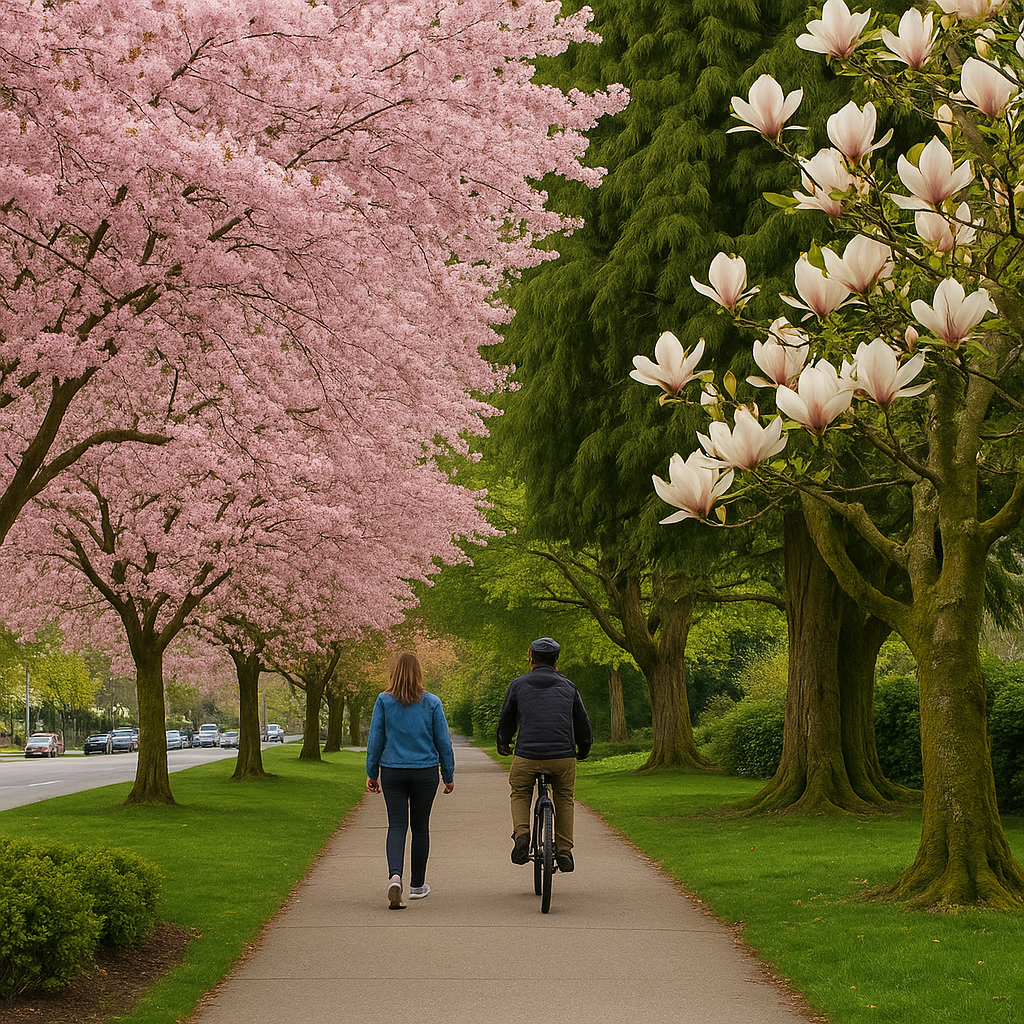
✍️ By Karalee Greer | WBN News – Kitsilano | June 14, 2025 Subscription to WBN and being a Contributor is Free.
🌳 kitsTREEmap
The kitsTREEmap is a unique, self-guided walking and biking route through one of Vancouver’s greenest neighbourhoods—Kitsilano. Created by nature advocate Ryanne Matthias, this 12 km circular loop showcases 14 special trees while celebrating the area's ecological and cultural roots. It’s a refreshing blend of urban forest, heritage, and outdoor adventure. https://www.bcmag.ca/kitstreemap/
🌿 Route at a Glance
- Length: ~12 km
- Walking Time: 3 hours (brisk), or full-day with stops
- Biking Time: 1–1.5 hours
- Start Point: Flexible (Kits Beach is a popular choice)
This route winds from Kits Beach to Vanier Park, up through leafy residential streets like Arbutus, Cypress, and Maple, and loops back along West Broadway and West 4th Avenue. It’s entirely flat and safe for families, with wide sidewalks, separated bike paths, and amenities like cafes and playgrounds en route.
🌲 What Makes These Trees Special?
The 14 trees on the route include:
- Hiba arborvitae near Kits Beach (Thujopsis dolabrata), tucked near the edge of Kitsilano Beach Park, is a rare Japanese conifer not often seen in urban landscapes. Its glossy, scale-like foliage with distinct silver undersides gives it an ornamental elegance, while its broad, multi-trunk form offers a unique silhouette compared to typical evergreens. Revered in Japanese temple architecture and landscaping, its presence here adds a touch of botanical exoticism and invites quiet curiosity from passersby. It’s a living lesson in both biodiversity and horticultural diplomacy.
- Massive Douglas-fir & Western red cedar—BC’s native giants. The towering Douglas-firs (Pseudotsuga menziesii) and Western red cedars (Thuja plicata) represent the ancient giants of the Pacific Northwest. These native trees once dominated the region’s pre-colonial rainforest and are still revered today for their ecological significance and cultural importance to Coast Salish peoples. On the kitsTREEmap, they stand like sentinels—offering cooling shade, homes to urban birds and squirrels, and a vertical reminder of Vancouver’s deep forest roots. Their deeply furrowed bark and immense height make them awe-inspiring for kids and adults alike.
- Cherry and magnolia trees—springtime stunners. Each spring, Kitsilano erupts in soft pink and white blossoms thanks to its cherry (Prunus spp.) and magnolia (Magnolia spp.) trees. Planted in abundance throughout the city after World War II, many cherry trees were gifted from Japan and have become symbols of fleeting beauty and renewal. Magnolias, with their large, tulip-like blooms and sweet fragrance, bloom just before the cherries—offering a layered floral performance. On the route, Vanier Park and the Museum of Vancouver are prime blossom-viewing spots, attracting photographers, picnickers, and dreamers alike.
- Katsura grove (Cercidiphyllum japonicum) in Seaforth Peace Park form a quiet, intentional grove planted to honour the victims of Hiroshima. With delicate heart-shaped leaves that turn brilliant gold and red in autumn, these trees are both visually striking and deeply symbolic. Katsura trees release a subtle, sweet scent reminiscent of burnt sugar as their leaves fall—an aromatic signature that complements their memorial purpose. As part of the peace grove planted in 1992, they offer a contemplative space where history, memory, and nature intersect.
- Shady maples, elms, and yews—lining historic boulevards. Kitsilano’s leafy charm owes much to its maples (Acer spp.), elms (Ulmus spp.), and yews (Taxus spp.), which line historic streets like Arbutus, Cypress, and Yew. These boulevard trees form a majestic canopy over sidewalks, particularly vibrant in autumn. Their dense foliage provides critical shade during summer, reduces urban heat, and filters air pollution—making them unsung heroes of environmental resilience. The elms, some over 70 years old, are living legacies of early city planning and beautification efforts. Walking under them is like entering a green cathedral.
Each tree is selected for its visual beauty, rarity, cultural meaning, or ecological role. Plaques, textures, and seasonal changes make them ideal for both education and appreciation.
Family-Friendly and Flexible
- Stroller-friendly, pet-welcome, and perfect for all ages
- Washrooms, water fountains, and picnic spots available
- Easily shortened into 2–3 km segments for younger kids
- Great seasonal highlights: cherry blossoms (spring), fall colour (autumn), cool shade (summer)
A Living History Walk
Kitsilano was built in the early 1900s with tree-themed street names and civic beautification plans. Walking this route is like flipping through a natural history book: it brings together Indigenous roots, colonial streetscapes, and modern ecological values—all expressed through trees.
🌞 When to Go
- Spring: Cherry and magnolia blooms
- Summer: Beach breaks + green canopy
- Fall: Fiery leaf displays
- Winter: Peaceful and uncrowded
✅ Tips for a Great Day
- Wear comfortable shoes or bring your bike
- Download the PDF map (kitsTREEmap)
- Stop for lunch on West Broadway
- Bring water, snacks, and sunscreen
- Be mindful—no climbing or peeling tree bark
The kitsTREEmap isn’t just a walking route—it’s a quiet revolution in how we see our neighbourhoods. It invites reflection, slows the pace, and offers discovery around every corner. Whether you’re a local or visiting Kits for the first time, this full-circle route gives you a fresh lens on the city—one tree at a time. https://citytreemap.com/
Karalee Greer - Publisher | WBN News – Kitsilano | June 14, 2025 Subscription to WBN and being a Contributor is Free.
Hashtags: #WBN Kitsilano #Karalee Greer #Urban Forestry #Explore Kitsilano #Vancouver Nature #Family Friendly Vancouver #Tree Tourism



